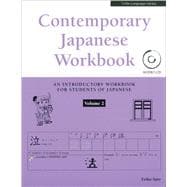Contemporary Japanese

Contemporary Japanese
- ISBN 13:
9784805314111
- ISBN 10:
4805314117
- Edition: Workbook
- Format: Paperback
- Copyright: 08/02/2016
- Publisher: Tuttle Pub
Rent
Sorry, this item is currently unavailable.
Note: Supplemental materials are not guaranteed with Rental or Used book purchases.
Extend or Purchase Your Rental at Any Time
Need to keep your rental past your due date? At any time before your due date you can extend or purchase your rental through your account.
Summary
Contemporary Japanese Workbook, Volume 2 was created as a supplementary material for Contemporary Japanese: An Introductory Textbook for College Students. A workbook which is best used for reviewing and reinforcing the concepts and learning materials introduced in the textbook, it is also designed to function as a standalone comprehensive workbook. Some of the features included for this purpose are (a) presentation of a brief note on the concept tested before every question, (b) providing of vocabulary and kanji glossaries on unfamiliar words, and (c) an audio input by native speakers. This workbook also offers materials in the business, traveling and daily life contexts, in addition to the college life context featured greatly in the textbook.
Contemporary Japanese Workbook series comes in two volumes, consisting of 26 chapters (Chapter One to Fourteen in Volume 1 and Chapter Fifteen to Twenty–Six in Volume Two) in all. It integrates all the information provided in the textbook. Each chapter in the workbook has specific objectives and includes the following six sections:
Contemporary Japanese Workbook series comes in two volumes, consisting of 26 chapters (Chapter One to Fourteen in Volume 1 and Chapter Fifteen to Twenty–Six in Volume Two) in all. It integrates all the information provided in the textbook. Each chapter in the workbook has specific objectives and includes the following six sections:
- Kanjia and vocabulary
- Grammar.
- Conversation and Usage.
- Listening Comprehension.
- Writing.
- New Vocabulary Reference List.







